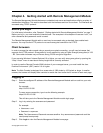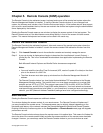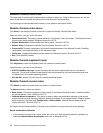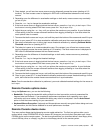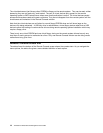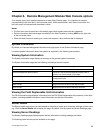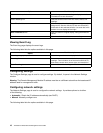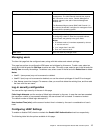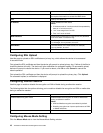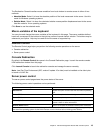
2. Once started, you will see two mouse cursors moving diagonally across the screen (starting at 0, 0
location). The local mouse cursor is displayed in RED color to differentiate between the two mouse
cursors.
3. Depending upon the difference in acceleration settings on both ends, mouse cursors may eventually
go out of sync.
4. Press the + or - key to change the acceleration settings.
5. If the local mouse cursor is lagging behind the host cursor, press the + key to try to be in sync. If the
local cursor is moving ahead of the host cursor, press the - key to sync it up.
6. Adjust the sync using the + or - key, until you achieve the maximum sync possible. A good indicator
of that setting is that the mouse movement switches from lagging to leading or vice-versa when the
most optimal value is crossed.
7. To ensure that both cursors are in sync, wait until they reach the bottom of the screen and are still in sync.
8. Once in sync, press ALT+A to stop acceleration calibration and save the current acceleration settings.
9. Now when acceleration sync is done, start mouse threshold calibration by selecting Calibrate Mouse
Threshold menu item or pressing ALT+T.
10. The behavior is same as in mouse acceleration case. Once started, you will see two mouse cursors
moving diagonally across the screen (starting at 0, 0 location). The local mouse cursor is displayed in
RED color to differentiate between the two mouse cursors.
11. Depending upon the difference in threshold settings on both ends, mouse cursors may eventually
go out of sync.
12. Press the + or - key to change the threshold settings.
13. If the local mouse cursor is lagging behind the host cursor, press the + key to try to be in sync. If the
local cursor is moving ahead of the host cursor, press the - key to synch it up.
14. Adjust the sync using the + or - key, until you achieve the maximum sync possible. A good indicator
of that setting is that the mouse movement switches from lagging to leading or vice-versa when the
most optimal value is crossed.
15. To ensure that both cursors are in sync, wait until they reach the bottom of the screen and are still in sync.
16. Once in sync, press ALT+T to stop threshold calibration and save the current threshold settings. At this
point, both local and the remote mouse cursors should be in synchronization.
Note: Once the acceleration calibration is preformed, you must calibrate threshold settings for the mouse to
be in sync.
Remote Console options menu
Using the Options menu, you can do the following:
• Bandwidth: Changing the bandwidth setting affects low-level connection protocol parameters like
fragment size and timeouts. If you experience performance problems when operating over a slow
connection such as a modem, the bandwidth setting may need to be adjusted. Use the Auto Detect
option to nd the correct setting for your connection.
• Keyboard/Mouse Encryption: Keyboard and Mouse data are normally encrypted before being sent over
the connection, but this can be disabled for a small performance increase.
Remote Console device menu
This menu option allows starting/stopping remote media redirection. The rst two options allow you to
redirect either a local CDROM/DVD drive or else an ISO image on your local client le system as a virtual
CDROM device on the remote system. The last two options allow you to redirect either a local oppy drive,
a local USB key drive, or a oppy .img le as a virtual oppy device on the remote system.
Chapter 5. Remote Console (KVM) operation 13





